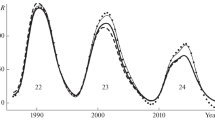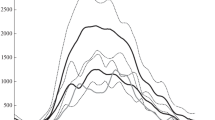Abstract
We propose a minimum level of the smoothed values for the solar constant during a period of low sunspot activity as a new additional criterion for determining the time of a minimum between solar cycles. An indicator for the time of a minimum between cycles is the time at which a minimum level in the average monthly values of the integral flux of solar radiation smoothed over thirteen months (when the last four values of the flux are greater than the previous minimum point) is achieved. We successfully tested the new criterion to determine the time of the previous minima between cycles 21 and 22, 22 and 23, and 23 and 24.
Similar content being viewed by others
References
Kh. I. Abdusamatov, “Long-Term Variations of the Integral Radiation Flux and Possible Temperature Changes in the Solar Core,” Kin. Phys. Celest. Bodies 21(6), 328–332 (2005).
Kh. I. Abdusamatov, “The Time of the End of the Current Solar Cycle and the Relationship between Duration of 11-Year Cycles and Secular Cycle Phase,” Kin. Phys. Celest. Bodies 22, 141–143 (2006).
Kh. I. Abdusamatov, “Optimal Prediction of the Peak of the Next 11-Year Activity Cycle and of the Peaks of Several Succeeding Cycles on the Basis of Long-Term Variations in the Solar Radius or Solar Constant,” Kin. Phys. Celest. Bodies 23, 97–100 (2007).
Kh. I. Abdusamatov, “The Longest 23th Cycle of Radiation and Activity of the Sun—is the Evidence of Deep Minimum of Two Secular Cycle in 2042,” in Solar and Solar-Earth Physics 2008, Proceedings of the All-Russia Conference on Solar Physics (St. Petersburg, 2008), pp. 3–4.
Kh. I. Abdusamatov, “An Optimal Method for Determining the Time of the Minimum of the 23rd Solar Cycle, July 2008,” Kin. Phys. Celest. Bodies 25, 150–152 (2009).
D. K. Callebaut and V. I. Makarov, “The Advent of a Grand Minimum and Climate Effests,” in Solar Activity as a Factor of Cosmic Weather, Proceedings of the 9th Pulkovo International Conference on Solar Physics (St. Petersburg, 2005), pp. 161–168.
M. A. Clilverd, E. Clarke, T. Ulich, et al., “Predicting Solar Cycle 24 and Beyond,” Space Weather 4, S09005 (2006).
J. A. Eddy, “The Maunder Minimum,” Science 192, 1189–1202 (1976).
J. A. Eddy, “The Maunder Minimum: A Reappraisal,” Solar Phys. 89, 195–207 (1983).
P. A. Foukal and J. L. Lean, “Magnetic Modulation of Solar Luminosity by Photospheric Activity,” Astrophys. J. 328, 347–357 (1988).
N. A. Krivova, S. K. Solanki, and T. Wenzler, “ACRIM-Gap and Total Solar Irradiance Revisited: Is there a Secular Trend between 1986 and 1996?,” Geophys. Rev. Lett. 36, L20101 (2009).
Author information
Authors and Affiliations
Corresponding author
Additional information
Original Russian Text © Kh.I. Abdusamatov, 2012, published in Kinematika i Fizika Nebesnykh Tel, 2012, Vol. 28, No. 1, pp. 59–64.
About this article
Cite this article
Abdusamatov, K.I. A new criterion for determining the time of a solar minimum. Kinemat. Phys. Celest. Bodies 28, 35–38 (2012). https://doi.org/10.3103/S0884591312010023
Received:
Published:
Issue Date:
DOI: https://doi.org/10.3103/S0884591312010023




